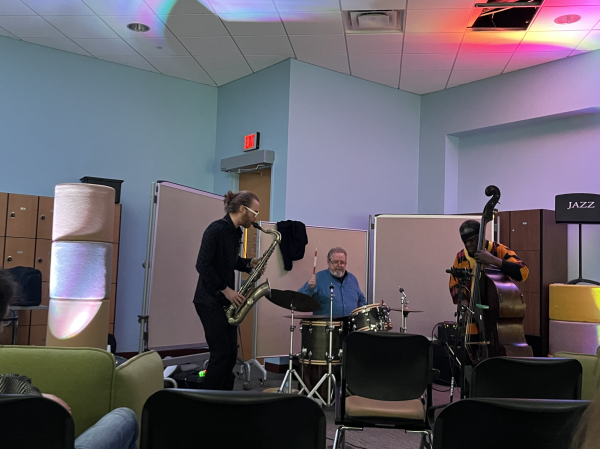13 Beats: Let’s Skip to Spring
In honor of the slow-but-on-a-roll feeling of our cold new semester transitioning to spring, here is a diverse list of tunes to help ease you into the new groove, inspired by Colgate University Libraries Blackmore Jazz Collection.
1. “Sugar Rum Cherry (Dance of the Sugar-Plum Fairy),” Duke Ellington (1960)
This iconic Christmas song comes from legendary jazz pianist “Duke,” who is honored in the Blackmore Jazz Collection. Its jazz melodies were intended to evoke the transformation of the iconic, graceful and pristine Sugar Plum Fairy, from the famous “Nutcracker” ballet, to the “Sultry Sugar Rum Cherry.” Along with the original “Dance of the Sugar-Plum Fairy” by Pyotr Ilyich Tchaikovsky (1892), these classics are often under-appreciated, as they have no lyrics. Still, their groovy Christmas spirit is straight out of a fairytale that, unlike lyrical music, can allow you to focus on studying
2. “Some Velvet Morning,” Lee Hazlewood, Nancy Sinatra (1967)
Hazlewood — a relatively obscure country artist, composer and producer — was asked by Frank Sinatra in 1967 to give his daughter’s career a boost. The result of the collaboration was a classic rock song with abstract lyrics inspired by the Greek mythology of the Cretan Princess Phaedra, who kills her stepson out of spite and lust. One delightful and unique characteristic of the song is that the rhythm is in the 4/4 time signature on Hazlewood’s part but speeds up to 3/4 on Sinatra’s part, a technique that was difficult to do back when songs were recorded live with an orchestra.
3.“In the End,” Linkin Park (2001)
Linkin Park’s earlier music is considered a fusion of heavy metal and hip hop, but most of their songs contain a darker undertone that easily conveys a nostalgic blues feeling. The sheer spirit of emotion, skill and effort put into Linkin Park’s lyrics is genuinely striking. “In the End,” in particular, is on this list because it holds the title of Linkin Park’s most famous song, with almost 1.5 billion streams on Spotify and covered by nearly 300 musicians globally.
4. “Creepin’,” Metro Boomin, The Weeknd and 21 Savage (2022)
Metro Boomin, The Weeknd and 21 Savage’s 2022 hit song “Creepin’” — heavily influenced by Mario Winans’ “I Don’t Wanna Know” — tells a story of heartache brought about by dishonesty and disloyalty, but a willingness to move on as if nothing happened. Melodically, it certainly leaves you with a distinctive melancholy chorus to ache for. This week, “Creepin’” is No. 2 on Billboard’s hot R&B songs list after previously holding the No. 1 spot.
5. “Don’t Wanna Breathe,” Kodak Black (2017)
Many of Kodak’s songs are more aggressive, but there are certainly exceptions that give some of his tracks an R&B feel. This is one of them. With slow and catchy lyrics, Kodak rhymes about his endless love for someone who allows him to relax and become gentler than he ever expected he could become. The song clearly sends the message that he “Don’t Wanna Breathe” if he is not with his lover.
6. “Lucid Dreams”, Juice WRLD (feat. Lil Uzi Vert) (2018)
“Lucid Dreams,” Juice WRLD’s most streamed song, is melodically very similar to Sting’s “Shape Of My Heart.” They practically have the same defining guitar riff. Still, Juice WLRD transforms the piece to reflect his imagination by adding to the melody and applying his own rhythm and lyrics. Both are phenomenal songs, but there are a lot of controversies regarding the connection that ties the two together. Sting obtained 85 percent ownership of the piece after its release and allegedly threatened to sue for exclusive rights, according to The Sun.
7. “Hail Mary,” Tupac Shakur (1997)
“Hail Mary” was released shortly after Tupac’s death as part of the first of seven posthumous albums. The song contains biblical references and guidance from “God” to help leave the “wild.” The song also touches on substance abuse and the institutionalization of the criminal justice system. “Hail Mary” is full of lyrics that hold a tangible meaning.
8. “Dilemma,” Nelly (feat. Kelly Rowland) (2002)
Nelly’s hit song conveys a male character, represented by American rapper, that is infatuated with a female character, represented by Rowland, who moves into the neighborhood with a partner but still reciprocates. High-pitched intonation, a call and response pater and a sample from Patti Label’s 1983 song “Love, Need, and Want You,” are the song’s signature components. “Dilemma” topped the charts internationally, and many consider it one of the best R&B songs of the 2000s.
9. “Wet Sand,” Red Hot Chili Peppers (2006)
Red Hot Chili Peppers: their name precedes them. “Wet Sand” is one of their less widely known songs and warrants more exposure. Often described as funk or alternative rock, the song gives a sort of swaying feeling. A catchy and sharp guitar riff melody dictates acceleration and deceleration along with changing lyrics as the song amps up progressively to finish with a guitar solo. The vibe and emotion induced by this song are second to none and surely a product of the blues.
10. “Runaway Train,” Soul Asylum (1993)
This song has a gentle acoustic guitar riff that could symbolize one of two things: runaway trains, or Dave Pirnir’s festering depression, fascination with trains and a friend who would pick up his calls at any hour. What could symbolize blues better.
11. “(Don’t Fear) The Reaper,” Blue Oyster Cult (1976)
With lyrics such as “Come on, baby (Don’t fear the reaper) Baby, take my hand (Don’t fear the reaper),” many fans have speculated whether the song is about a suicide pact. Donald “Buck Dharma” Roeser — writer, lead singer and lead guitarist — insists it is about “eternal love.” Regardless, this sinister and aggressive song is widely hailed as one of music’s best, most memorable classic rock songs.
12. “Time of the Season,” The Zombies (1968)
In this track, The Zombies give a short and sweet song about it being “the time of the season for loving.” The seductive nature of the song — created by call-and-response vocals, heavy breathing, organs, drums and an improvised piano straight out of 60s psychedelia — adds hints of R&B and rock, inducing the perfect atmosphere for the next song.
13. “Sexual Healing,” Marvin Gaye (1982)
“Sexual Healing,” a song from Gaye’s last album before his untimely death, is about his healing from depression and drug addiction. “Sexual Healing” was primarily composed of drums, a synthesizer, different light drums and hi-hats, rhythmic guitar and a rhythmic piano that weaves a melody. After every period of blues in life, there must be healing. Perhaps this song may serve as good advice to remedy the blues as a passage into the spring.






